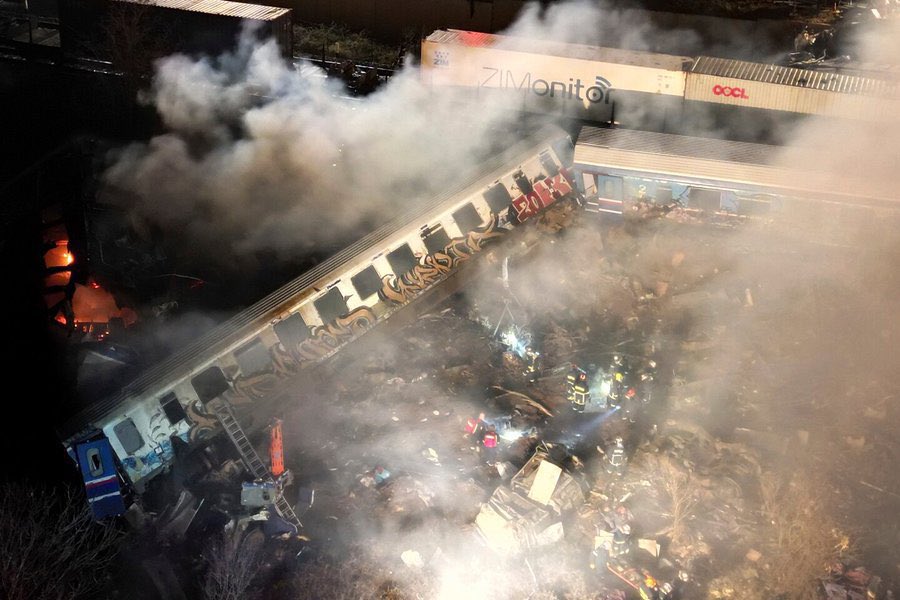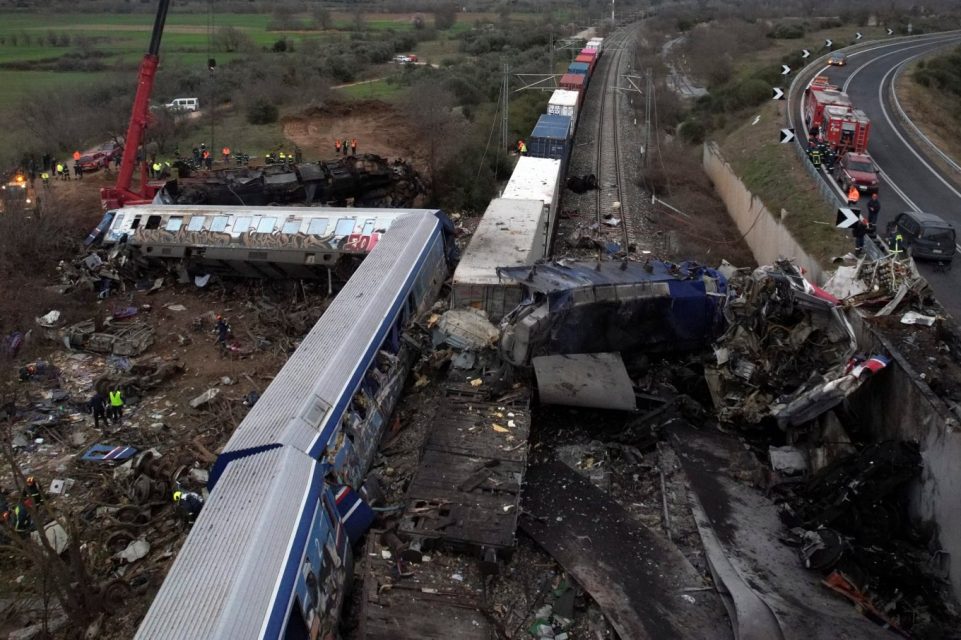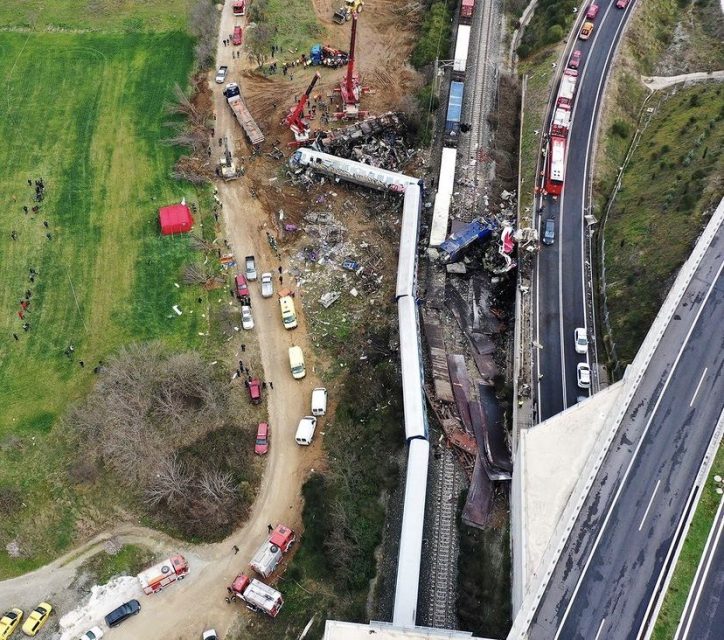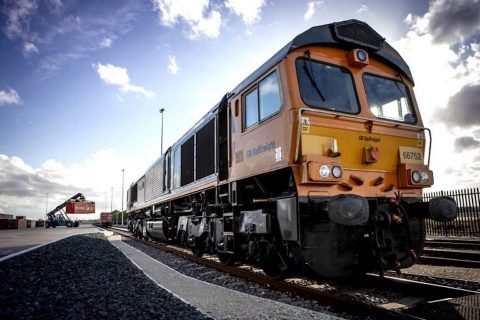Rail accident Greece: human error or systematic neglect?

The tragic railway accident involving a passenger and freight train in Greece has shocked the country and the world. With at least 46 people dead, and dozens missing and wounded, the accident triggered a series of resignations, including that of the Greek minister of transport. So far, it is attributed to human error that occurred due to “bad timing”; however, is this indeed the case?
The accident happened shortly after midnight on 1 March near the city of Larissa. The crash involved a passenger train travelling from Athens to Thessaloniki carrying around 350 people. Just before the Vale of Tempi gorge, there was a head-on collision with a freight train. Both trains were reportedly travelling at high speed. The total fatalities are still unknown, with rescuers working tirelessly to locate survivors and pull out bodies from the destroyed wagons. Unfortunately, some estimations say that the death count could reach 70 people.
Read the accident’s report here.
Among the accident’s immediate repercussions was also the resignation of the Greek transport minister Konstantinos Karamanlis, who explained that he cannot remain in the position after so many people got lost. Additionally, he mentioned that he does so to assume responsibility for the mistakes of the past and present governments, which led to this tragedy.
Caption below: Video footage showing the explosion after the two trains collided.
Βίντεο με την έκρηξη που δημιουργήθηκε από την σύγκρουση των τρένων. #Τεμπη #παμε_και_οπου_βγει #hellenic_train #συγκρουση_τρενων #τραγωδια pic.twitter.com/LNlkdLRLeS
— Γιώργος (@giorgosand16) March 1, 2023
Human error
Shortly after the accident, the station master of Larissa, on duty for traffic management when the tragedy occurred, was arrested and questioned by the Greek police. In his words, the accident resulted due to “bad timing” since, by mistake, he asked the passenger train to switch lines without realising that a freight train was also transiting on the same track. As a result, a few minutes later, the two trains crashed.
As he explained to the authorities, he was new at the job – a job that is done manually, with no IT or other systems to manage rail traffic and signalling. The Greek prime minister Kyrgiakos Mitsotakis backed the same narrative, stating during a press conference that the accident owes primarily to human error. Yet, a series of resignations and the arguments of railway workers might suggest otherwise.

Transport minister resigns
A few hours after visiting the accident site, the Greek transport minister Konstantinos Karamanlis resigned. In a statement, he said that he regrets the loss of so many people and that he takes responsibility for the continuous mistakes of Greek governments that downgraded the country’s railway network.

At the same time, the heads of OSE, the Greek infrastructure manager, and ERGOSE, the company carrying out infrastructure works, also resigned, taking part in the disaster’s responsibility. Nevertheless, what the former transport minister Karamanlis underlined when mentioning the years of governmental mistakes, might amalgamate the whole rail situation in Greece that produced the conditions for such a large-scale accident.
No traffic control system
When looking at the accident’s background, it is easy to realise that it was a matter of time before happening. Railway workers had announced in early February that safety measures in Greece are insufficient to ensure safe train traffic across the country, thus resulting in frequent accidents or incidents. Ironically, they also warned that Greek authorities should not wait for a major accident to occur to take action and proceed to upgrades.
However, there’s more than that. Kostas Genidounias, the Greek train drivers association president, stated in Geek media: “Nothing works; neither the lights work nor the traffic control. Everything takes place manually, and information is given by the station master through a radio all over the Athens-Thessaloniki axis. If the systems worked, the drivers would have seen the red signals and stopped 500 metres before the collision”.

Nine years of neglect
When asked why there are no electronic systems to monitor railway traffic in Greece, he said: “We have electronic systems, but they don’t work, ask those responsible”, hinting to the transport ministry and the governments ruling Greece from 2000 onwards.
Indeed, Greece was supposed to adopt ETCS in the mid-2000s. Τhe first state budget for this purpose was approved in 2007, including the EU’s co-financing. Works started in 2014 and were supposed to complete by 2020, but this never happened. Four billion euros and a tragic accident later, ETCS is either missing from most of Greece’s network or is not updated.
Not the first resignation
In this context it’s not surprising that the head of the Greek ETCS commission resigned in April 2022. In his resignation letter, he explained that he was leaving his position because the transport ministry and the government did not implement the signalling and safety agreements that should be in place for years already. He explicitly said that trains in Greece can move at 200 kilometres per hour without the slightest clue about the track conditions.
This is why, a few days before the accident, on 15 February, the EU Commission decided to refer Greece to the Court of Justice of the European Union for failing to comply with rules on railway transport. Specifically, Greece failed to fulfill obligations under the Single European Railway Area Directive that dictates authorities to conclude and publish contractual agreements with railway infrastructure managers. Simply put, the directive aims to provide transparency in certain processes like obligation fulfillment and emergency management.
Also read: Greece: at least 40 dead, 85 injured following passenger and freight train collision





Regardless which:
Human factor is a too well known and documented, risk factor, a factor now, year 2023, in most cases safely omittable – and duly shall be!
Accordingly, if I was to judge: in no respect Tragedy was an accident but, more relevant, the result – of “wreckless driving”!)
(Too often media, “ours”, etc. forgivingly use “accident”…)